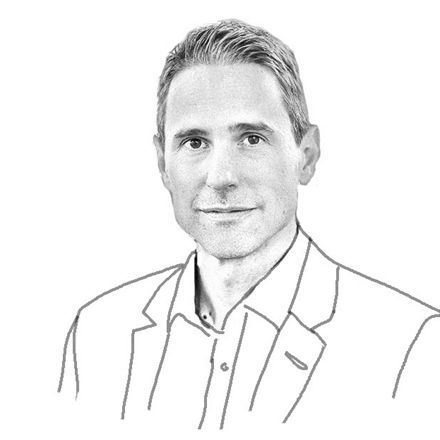Professor Schüth, for the past quarter of a century you have been working to make the chemical industry sustainable—often in the face of opposition. Does it give you a sense of satisfaction that defossilization is suddenly being promoted so much?
SCHÜTH In view of the war in Ukraine, satisfaction is certainly the wrong word in this case. But it is a good sign that when faced with this dire situation, we were able to build a liquefied gas terminal in Germany within five months, for example. I’m concerned, however, that we will revert to our former complacency and perhaps fail to feel the same urgency with regard to climate change once the current energy crisis is over. But at least we now have an example that shows that we can do it. It’s possible.
Not only governments but also industry has contributed to the fact that the transformation to a climate-friendly economy has been proceeding slowly for a long time. Do you think people are now realizing that action is needed?
I am 62 years old, and I have long since given up any illusions I may have had that things are done as a result of altruism. If you want radical changes, you either have to pass tough laws or make them pay off. Economic considerations are hard to beat. On days when I’m optimistic, I say to myself: People will behave differently because they’ve recognized the problem. On days when I’m pessimistic, I say to myself: Technology will have to solve this issue. We need to provide technological alternatives that enable us to operate sustainably.
In the chemical industry, there are essentially two paths to greater climate change mitigation. Either we change the core processes of production, or we rely more on the established processes—but with a green energy supply, renewable raw materials, and a circular economy. Which path is more likely to lead to the goal?
We have to pursue both paths. Of course you can implement entirely new processes, products, and platform molecules. However, the greatest effect will be achieved by means of a sustainable raw material base and a sustainable energy supply. It is important to move forward now as quickly as possible. In doing so, we have to maintain the links in the value chain but rely on a sustainable basis.
What might such an approach look like in the chemical sector?
In the chemical production process, we need heat and compression. This is typically mechanical work. We can provide heat via electric heating or heat pumps. You have to do a lot of development work there, but it works. And instead of a gas turbine or a combined cycle system, you can use electric compressors. There are even plans for an electric-powered steam cracker—there’s nothing that needs much more concentrated energy input than that. This shows that it’s possible!
And what about raw materials?
Achieving a sustainable basis is a bit more difficult here. We need to move away from our basic chemicals, which are derived from oil or natural gas. And we can only accomplish that if we use CO₂, biomass or waste materials—especially plastics—as a source of carbon. From CO₂, I can get directly to methanol via hydrogenation with hydrogen. Or we generate synthesis gas via a reverse water gas shift reaction: CO₂ plus hydrogen results in CO and water. I can then extract methanol, hydrocarbons or aromatic compounds from this synthesis gas. There are already plants that produce several tens of thousands of tons per year. Many of them are in China. What worries me a bit on behalf of German companies is that even though the methanol in China is still produced from coal, the manufacturers there are gaining the experience needed to eventually operate plants that may produce 100,000 tons per year.
What role do plastics and biomass play with regard to raw materials?
If you want to use polymers as a carbon base, you have a number of options. They can be selectively depolymerized to return them to monomers or to monomer-related molecules. Or you pyrolize them. The resulting pyrolysis oil must be reprocessed to obtain a feed for the steam cracker. Biomass is probably a good source of raw materials for part of our supply of aromatic compounds, because the lignin it contains is rich in them. Here too, companies already have experience with the operation of plants producing several tens of thousands of tons per year.
Where do you see opportunities to switch to alternative raw materials relatively quickly and without compromising quality?
Take polyethylene terephthalate, for example, which we know as PET. The terephthalic acid it contains is ultimately produced from petroleum. We could replace it with an alternative monomer: furandicarboxylic acid that can be produced from biomass, namely cellulose. This means that the product does not have exactly the same properties, but this problem will be solved.

At Evonik and in many other companies, ammonia is needed for chemical processes. What climate-friendly alternatives to fossil sources such as natural gas or naphtha do you see there?
If we use green hydrogen instead, produced via electrolysis with sustainable electricity, a large part of the CO₂ footprint disappears. If the compressors required for the process are also operated electrically, ammonia can be produced in an almost climate-neutral manner. In addition, however, it’s necessary to conduct a life cycle analysis of the plant itself. As long as I need steel and concrete to construct chemical plants, we’ll be lugging around the CO₂ burden of these materials, but we can lighten that too.
When you think of steel, do you think of production methods such as direct reduction with hydrogen?
Exactly. Of course, this only makes sense if we use electrolysis hydrogen and not hydrogen produced from natural gas. It is much more difficult when it comes to cement for concrete, for which we have to roast calcium carbonate to get lime. The carbon dioxide released in this process accounts for about three percent of global emissions—more than all air traffic. To be honest, I don’t see a real solution here yet.
A lot of what you’re talking about works with electricity, which ideally is produced sustainably. What makes you so confident that this green energy will be available in sufficient quantities in the foreseeable future?
If we wanted to supply the entire chemical industry with hydrogen from sustainable energies and hydrogenate CO₂, we would have to install about 1.5 square kilometers of photovoltaics every day worldwide from now until 2050. These are gigantic numbers, but it seems feasible. We just can’t afford to spend another ten years thinking about what we want to do. We have to do it now.

»What the chemical industry has invested here over the past decades is a huge asset«
Ferdi Schüth Director of the Max Planck Institute
In Europe, especially in Germany, it will hardly be possible to build such capacities. Do you see a danger that the chemical industry will migrate to regions of the world where it is easier to produce green electricity?
I am reasonably confident that Germany will remain an important industrial site. Even today, chemical production only partially takes place where the oil and gas wells are located. The raw materials are transported here instead. Why should this be fundamentally different when we use raw material sources generated with green electricity? If methanol were to become an essential molecule in the chemical industry, then hydrogen could be produced with solar energy in North Africa or Australia, for example. This hydrogen would also be used to produce methanol in those regions. The methanol can then be shipped to Leverkusen, Ludwigshafen or Herne to produce raw materials.
However, the current value chain was created when Europe was still a dynamic market. Many countries that are suitable for the methanol production you mentioned want to keep a significant share of the value creation process within their borders and set up their own chemical production facilities.
That can happen, of course. But what we have invested here over the past decades is a huge asset. Why tear it all down and build anew elsewhere? If we maintain value chains, logistics, and distribution, but make our raw material base sustainable, we may stand a chance against what is being newly installed elsewhere. In addition, I am convinced that it is easiest to transport the basic raw material on a large scale to the point of consumption, where it can be further processed into the many differentiated products of the chemical industry close to the customer. Doing this in the Sahara, for example, wouldn’t make any sense. But we will probably have to give up a part of the pie.
Green power producers are one group of competitors, the other are countries where CO₂ certificates are cheaper than in Germany—for example China and India. Do we run the risk of industries with high CO2 emissions relocating there at short notice?
I do see a danger of that happening. And we should counter it with import taxes, the amount of which is determined by the CO₂ burden that a product carries with it. I know that economists are generally not in favor of tariffs, because trade that is as unrestricted as possible makes life easier and produces cheaper solutions. But if we recognize the need to reduce CO₂ emissions to zero as quickly as possible to keep the Earth habitable, then we have no choice. The more countries that agree to this, the better, because it means that countries with lax limits for carbon dioxide will no longer be so attractive.

We can no longer rely on natural gas or electricity coming from the grid at any time of the day or night—at least since the Russian invasion of Ukraine. Isn’t this one of the reasons why industrial sites have to secure their energy supply better in order to ensure continuous production?
The idea of being self-sufficient won’t let us achieve this goal. The world is networked and will become even more networked. If we diversify our energy sources more, the system will be less vulnerable to disruption. The same applies to raw materials.
But shouldn’t we still make greater use of waste heat and waste from production sites as sources of energy and raw materials?
Definitely. One should look at everything that offers opportunities. But before I go to a lot of expense to use a heat flow of 50 degrees locally for production, I should rather get electrical energy from the Sahara, which can be produced there for 0.8 cents per kilowatt hour. With the waste heat of 50 degrees, we can heat a greenhouse in the neighborhood to grow tomatoes in winter rather than using it to run a high-temperature process, for example.
Do you have the impression that at least the European countries are pulling together on the climate issue?
The willingness is certainly there, because there is a rapidly growing realization of the problems we face due to climate change. Still, it’s difficult to get different countries to follow the same path. The French, for example, reproach us for continuing to operate lignite-fired power plants and shutting down nuclear power plants—which increases the price of CO₂ throughout Europe. We have to act together because we are all in the same boat now.

»If we diversify our energy sources more, the system will be less vulnerable to disruption«
Ferdi Schüth Director Max Planck Institute
As a scientist, what is your position on this issue?
This debate has to be conducted by society as a whole. Put simply, we cannot simultaneously insist on maintaining security of supply, keeping the moral high ground, safeguarding our industrial base, and pushing CO₂ emissions down to zero. Compromises will have to be made in some areas. Germany lacks a list of priorities on which we as a society can largely agree.
Over the next ten years, 800 billion euros are to be invested in Europe to drive forward the green transformation of industry. What will it take to make this mammoth undertaking a success?
First and foremost, planning security. Clearly, we need to expand renewables here at home as quickly as possible, and—where reasonably low cost is possible—enter into reliable contracts with energy producers elsewhere in the world. If in doubt, I would also have the state subsidize such supply relationships so that the business models can be firmly established. If we don’t get these logistics chains up and running now, the German chemical industry will be cut off at some point. At the same time, we need the priority list that I mentioned. And we must not call it into question every two years. It would be best to clarify this at the European level, even if it makes the discussion more difficult.
Around a quarter of a century from now we’ll be in the year 2050, when the European Union aims to be climate-neutral. Based on your experience, how likely do you think this is?
We’ll achieve it technologically if we launch a kind of mega Apollo program. There are, of course, sectors such as the cement industry where we currently don’t even have any idea of how we can get rid of CO₂. We will therefore have no choice but to take CO₂ out of the cycle elsewhere to compensate—for example, through reforestation programs, land use change or through carbon capture and storage, or CCS for short. The biggest difficulty, however, is that we are not dealing with a purely technological problem, but instead have to get society to pull together globally. That will be the real challenge.



